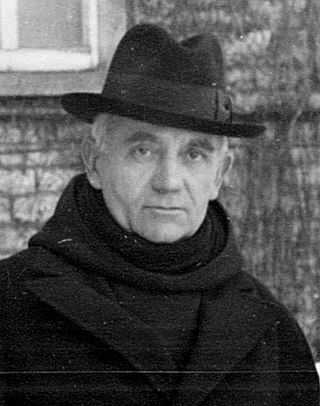
The Benedictines, officially the Order of Saint Benedict, are a mainly contemplative monastic order of the Catholic Church for men and for women who follow the Rule of Saint Benedict. Initiated in 529, they are the oldest of all the religious orders in the Latin Church. The male religious are also sometimes called the Black Monks, especially in English speaking countries, after the colour of their habits, although some, like the Olivetans, wear white. They were founded by Benedict of Nursia, a 6th-century Italian monk who laid the foundations of Benedictine monasticism through the formulation of his Rule. Benedict's sister, Scholastica, possibly his twin, also became a religious from an early age, but chose to live as a hermit. They retained a close relationship until her death.

Solesmes is a commune in the Sarthe department and Pays de la Loire region of north-western France.

Paul Louis Denis Bellot was a French monk and modern architect.

Quarr Abbey is a monastery between the villages of Binstead and Fishbourne on the Isle of Wight in southern England. The name is pronounced as "Kwor". It belongs to the Catholic Order of St Benedict.

Dom Joseph Pothier, O.S.B. (1835–1923) was a worldwide known French prelate, liturgist and scholar who reconstituted the Gregorian chant.

Stanbrook Abbey is a Catholic contemplative Benedictine Monastery with the status of an abbey, located at Wass, North Yorkshire, England.

Solesmes Abbey or St. Peter's Abbey, Solesmes is a Benedictine monastery in Solesmes, Sarthe, France, and the source of the restoration of Benedictine monastic life in the country under Dom Prosper Guéranger after the French Revolution. The current abbot is the Right Reverend Dom Abbot Geoffrey Kemlin, O.S.B., elected in 2022.

Prosper Louis Pascal Guéranger was a French priest and Benedictine monk, who served for nearly 40 years as the abbot of the monastery of Solesmes. Through the new Abbey of Solesmes, he became the founder of the French Benedictine Congregation, which re-established Benedictine monastic life in France after it had been wiped out by the French Revolution. Guéranger was the author of The Liturgical Year, a popular commentary which covers every day of the Catholic Church's liturgical cycles in 15 volumes. He was well regarded by Pope Pius IX, and was a proponent of the dogmas of the Immaculate Conception and of papal infallibility.

The Solesmes Congregation is an association of monasteries within the Benedictine Confederation headed by the Abbey of Solesmes.

Appley is an area of Ryde on the Isle of Wight. Until the early 1960s, it was largely based on the former English country house of Appley Towers and neighbouring Appley Farm. The area's character changed with the construction of the Appley housing estate – a development of mainly detached houses and bungalows, built on either side of the B3330 Ryde to St Helens road. The names of the roads on the estate relate mostly either to proximity of the sea or refer to Cumbrian lakes. The area to the north of the Appley housing estate is now a public park, with the Solent beyond. The stone-built tower by the sea wall dates from the days this land was the property of the Hutt family, as does the parkland itself, the latter being laid out to a design by Humphry Repton in 1798. In 2008, Appley Park became the first open space on the Isle of Wight to be awarded a Green Flag. The large villa just off the B3330 road, known previously as "Little Appley" at one time accommodated a school, as shown by the remaining sports field which adjoins it. This field is the home of archery club Wight Bowmen. The former school building now operates as a hotel and restaurant under the name Appley Manor. Appley House was the residence of Mr. Clayton.
St. Cecilia's Abbey, Solesmes is a Benedictine convent, founded in 1866 by Dom Prosper Guéranger, the restorer of Benedictine life in France after the destruction of the revolution. It is located in Solesmes, Sarthe, and is the women's counterpart of Solesmes Abbey.

Mère Cécile Bruyère was the first abbess of St. Cecilia's Abbey, Solesmes and a follower of Dom Prosper Guéranger in the revival of Benedictine spirituality in 19th century France.
Aelred Sillem was second abbot of Quarr Abbey, on the Isle of Wight, from 1964 to 1992.

Carisbrooke Priory was an alien priory, a dependency of Lyre Abbey in Normandy. The priory was situated on rising ground on the outskirts of Carisbrooke close to Newport on the Isle of Wight. This priory was dissolved in around 1415.
Appley House is an English country house and abbey in Appley Rise, Ryde, Isle of Wight.

In This House of Brede is a novel by Rumer Godden published in 1969 by Viking in the US and by Macmillan in the UK.

St. Paul's Abbey, Oosterhout, also Oosterhout Abbey is a former Benedictine abbey in Oosterhout, North Brabant, the Netherlands.

Mary David Totah OSB, known as Sister Mary David, born Michelle Frieda Totah, was an American nun who became prioress of St Cecilia's Abbey on the Isle of Wight, England.
St or St. Cecilia's Abbey may refer to:
The Immaculate Heart of Mary Abbey is a Benedictine abbey located in Westfield, Vermont.

















